CNN got a look at Iran’s drones and missiles, what did it show?
Iranians boasted to CNN about their missile and drone program recently, providing a tour of an exhibit that shows off Iran’s capabilities. The goal for Tehran is to showcase the weapons it used against Israel in the April 13-14 attack.
This is also a way for Iran to show it has the ability to launch missile and drone attacks on other countries, with virtual impunity. Iran, now in the fifth decade of its regime, believes it is at a turning point and on the verge of becoming a premier military-technology power in the region.
Islamic Revolutionary Guard Corps Brigadier General Ali Belali hosted the tour. “Two weeks after the Middle East came to the brink of an all-out war, with Iran firing hundreds of projectiles toward Israel in retaliation for a suspected Israeli airstrike on an Iranian embassy compound in Damascus, Tehran is keen to show the world that it is capable of fighting a wider conflict should it be faced with one,” CNN noted.
According to the report CNN got “rare” access to the exhibit. “American media had never been allowed inside until now,” the report said. The site is in western Tehran and has “dozens of long- and medium-range ballistic missiles” alongside drones and cruise missiles. “Today, our drones and missiles have become an important factor of strength and the execution of power in the world,” Belali said. The IRGC now claims its missiles are accurate to within five meters, which would be an extraordinary achievement if it were true.
The Iranian display also showed off its drone program. “While the Iranians acknowledge using dozens of Shahed 136 drones to target Israel, both the US and Ukraine also accuse Tehran of giving hundreds to Russia, with Moscow using them to hit Ukrainian cities and energy infrastructure,” the report noted.

Of interest here is a comment by the Iranian officer where he says “everything is preprogrammed. The flight route is chosen according (to) the enemy’s capabilities and blind spots of radars and all the elements that can help us reach the target.”
This is an important comment because it indicates that Iran’s drones don’t have a “man in the loop” and can’t be called off once launched. This was already widely assumed, but it’s important because it means that the slow drones, which can take hours to reach a target, have to be shot down.
This is an important comment because it indicates that Iran’s drones don’t have a “man in the loop” and can’t be called off once launched. This was already widely assumed, but it’s important because it means that the slow drones, which can take hours to reach a target, have to be shot down.
The degree to which jamming their communications or GPS will work is not clear because if they are preprogrammed on a flight path the path may not need to rely on outside applications or mapping coordinates. This means Iran’s use of more simple technology may actually benefit it in a world that relies on electronic warfare and other means these days to stop drones.
Iran can transport weapons disguised as civilian goods
The article also showcased a truck used to launch drones. The drones are lined up in the back of the truck in such a way that they can be transported in the guise of being a normal commercial truckload of fruit or bricks or anything that might be put on a truck, but when launched the truck’s metal frame is adjusted to a 45° angle so that the drones launch easily. This demonstrates the overall method of the Iranian regime which can smuggle weapons under wraps on civilian trucks, making them hard to find.
Iran also told CNN it used the Ghadr, Emad and Kheybar missiles in its attack. “The missiles have a range of more than 1,000 miles (1,600km.) and can carry warheads between 450 and 500 kg.” the IRGC officer told CNN. The Kheybar missile also has a 320 kg. warhead, the report noted. It has used these missiles before in attacks and in training, attempting to showcase its development of precision weapons.
The Iranian attack on Israel was mostly a failure, but it demonstrates the regime’s impressive capabilities and its willingness to terrorize the region.





Comments are closed.